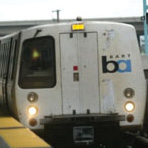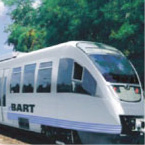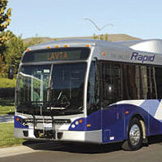Project Alternatives
The Project EIR evaluates a BART rail extension as the proposed project, along with three other transit alternatives, and a "no project" alternative. The alternatives are:
A. Conventional BART Extension (proposed project)
B. Diesel Multiple Unit (DMU) or Electric Multiple Unit (EMU) Alternative
C. Express Bus/Bus Rapid Transit (BRT) Alternative
D. Enhanced Bus Alternative
E. No Project Alternative
A summary of the different types of technology used with each alternative is presented below: A. Conventional BART Extension B. Diesel Multiple Unit (DMU) or Electric Multiple Unit (EMU) With this alternative, the BART to Livermore DMU would have run in the median of I-580 from the existing Dublin/Pleasanton Station to a new DMU station near the Isabel Avenue/ Interstate 580 interchange. Passengers would transfer to the DMU train from a shared platform at BART’s existing Dublin/Pleasanton Station. This alternative would require a storage and maintenance facility near the system's end-of-line. Several locations were evaluated for the storage and maintenance facility, and BART chose a location north of I-580 and west of North Livermore Avenue. As an option to the DMU, BART also evaluated an Electric Multiple Unit (EMU), a vehicle similar to a DMU that uses an electric motor and receives power through a system of overhead electric cables. All other aspects of the EMU would have been the same as a DMU. C. Express Bus/Bus Rapid Transit (BRT) Alternative D. Enhanced Bus Alternative |     |
Evaluation of the Alternatives
The Project EIR evaluates all the alternatives for ridership benefits, costs and environmental impacts such as air quality, noise and vibration, water resources, biological resources, transportation, land use and agricultural land, housing and physical displacement, community services, energy, greenhouse gases, geology and seismicity, hazardous materials, visual resources, cultural resources, public utilities, and growth-inducing impacts.
More specifically, some of the factors and questions the Project EIR considers include the following:
Land Use Compatibility – What are the impacts to existing land uses in the area? What potential displacements might occur? What are possible mitigations?
Transportation – What effects are there on local circulation, station access, transit system ridership, operations, transit connections and parking?
Wetlands/Biological Impacts – Will there be direct or indirect disturbances to sensitive areas such as wetlands, creeks, and undisturbed grassland, or to sensitive species in such habitats?
Safety Considerations – Do the Livermore Airport safety zones have implications for the project?
Air Quality Impacts – What are the effects of air emissions from transit system construction and operation? What air quality benefits could occur on the local, and regional levels from providing a transit alternative to the automobile?
Noise and Vibration Impacts – What are the local effects on schools, parks and playgrounds, senior centers or other sensitive receptors along the alignment and near the station area?
Visual Impacts – How would the transit improvements affect adjacent views, including the City of Livermore’s scenic corridor? Are there concerns related to the project’s height or scale compared to adjoining development?
Capital Cost
| Capital Cost (year of expenditure $) | ||||
| Conventional BART | DMU | EMU | Express Bus/ BRT | Enhanced Bus |
| $1,635 million | $1,600 million | $1,670 million | $380 million | $25 million |
Ridership Projections
| Projected Increase in BART Systemwide Boardings | |||
| 2040, average weekday | |||
| Conventional BART | DMU/EMU | Express Bus/ BRT | Enhanced Bus |
| 11,900 | 7,000 | 3,500 | 400 |